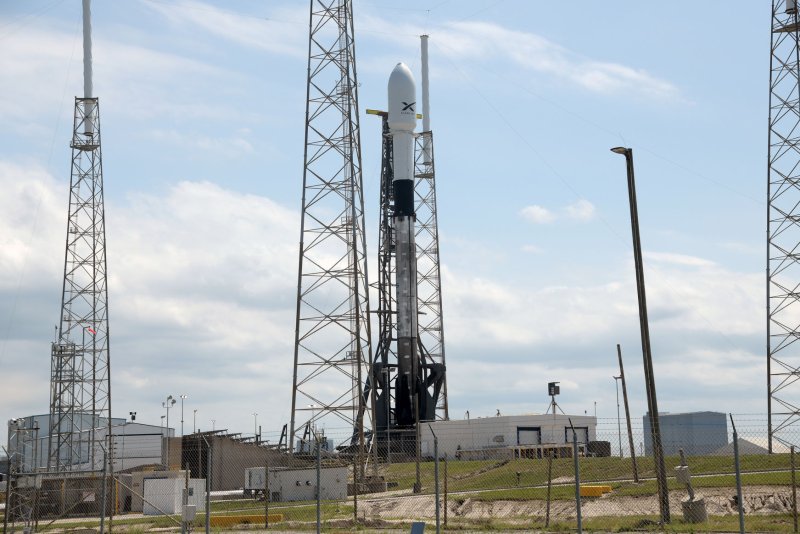1 of 3 | The SpaceX Falcon 9 rocket prepares to launch the company's Starlink satellites from Complex 40 at Florida's Cape Canaveral Air Force Station on Wednesday. Photo by Joe Marino-Bill Cantrell/UPI |
License Photo
CAPE CANAVERAL, Fla., May 15 (UPI) -- SpaceX scrubbed its first Starlink satellite launch Wednesday night, and plans to try again at 10:30 p.m. Thursday from Cape Canaveral, Fla.
The launch is aimed at delivering 60 satellites as part of SpaceX's own high-speed Internet service.
Minutes before the liftoff Wednesday night, SpaceX scrapped the launch, posting on Twitter: "Standing down today due to excess upper level winds."
With a new service launching for the first time, SpaceX founder Elon Musk had tweeted earlier, "Much will likely go wrong." In a news conference, he said the space company is experimenting with two ways to deploy the solar arrays, and one of those methods might not work, or the thrusters might not work as planned.
Musk provided a photo of the satellites packed inside the nose cone of the rocket awaiting launch.
The Starlink payload will ride aboard a Falcon 9 rocket from Launch Complex 40 into low-Earth orbit. With few clouds expected, the launch might be seen from around Central Florida.
SpaceX has launched demonstration satellites, but those planned to be sent aloft this week are the first real Starlink satellites. According to the Air Force's airspace closure warning, the first 60 satellites are dubbed Version 0.9, indicating the satellites still might not be in final "Version 1" configuration.
SpaceX is one of several big players trying to start new networks that use thousands of non-geostationary satellites to offer high-speed Internet and other types of communication around the globe. The focus is on boosting Internet access to rural areas first.
In a conference call Wednesday, Musk said the satellites will deploy within an hour after launch, most likely over Tasmania.
Musk said the launch of 60 satellites is the heaviest payload the Falcon rocket has ever carried.
The cost of launching each small satellite is pricier than building it, he said. Therefore, the company hopes to get its much larger rocket, the Starship, into action soon.
"We'd like to get Starship active as we deploy the constellation [of Starlink satellites] but it isn't required," Musk said.
He added that "it looks like" SpaceX has the capital necessary to get the Starlink network up and running commercially. That would require about 1,800 satellites to have full global coverage.
Such a huge network still would be dwarfed by the vastness of space, but the satellites will include a "collision avoidance" feature. After their useful life, they simply would burn up upon entering the atmosphere.
Musk said that the North American Aerospace Defense Command tracks all objects in orbit, and SpaceX uploads that database to the satellites, which use the data to avoid collisions by firing mini-thrusters powered by the chemical element krypton.
Musk said the company will not sell any satellite services until the network is operational, and that SpaceX would be open to launching competitors' satellites.
Others companies working on large new constellations include OneWeb, which launched its first six satellites in February, and Telesat.
SpaceX first filed for permits for the new constellation of satellites in 2016.
The Federal Communications Commission approved a SpaceX application in 2018 to "provide broadband services using satellite technology in the United States and around the world." SpaceX has indicated plans to launch up to 12,000 satellites eventually as part of the booming NewSpace era.















